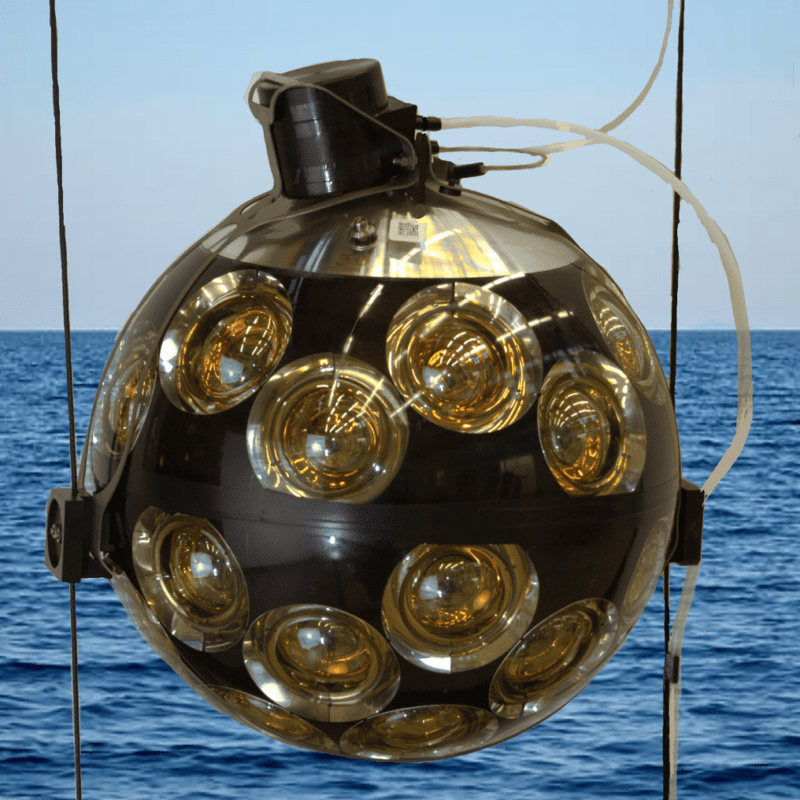Highest energy neutrino observed from undersea telescope
There’s a telescope sitting more than a mile and a half under the Mediterranean Sea, where no sunlight can reach. In this inky darkness, the Kilometer Cubic Neutrino Telescope (KM3NeT) waits for a neutrino – a weakly interacting particle – to show up. And now one has shown up, in a big way. The KM3NeT collaboration said on February 12, 2025, that its telescope has caught a neutrino with the highest energy observed so far, 220 Petaelectronvolt (PeV, a measure of an amount of kinetic energy). That’s equal to 220 million billion electron volts.
The telescope first caught the neutrino on February 13, 2023. After an exhaustive analysis and interpretation of data, the researchers published their findings in the peer-reviewed journal Nature on February 12, 2025. They named the event KM3-230213A, and it provides the first evidence that such energetic neutrinos are even possible in our universe.
Co-author Paschal Coyle of the Centre National de la Recherche Scientifique in France said:
KM3NeT has begun to probe a range of energy and sensitivity where detected neutrinos may originate from extreme astrophysical phenomena. This first ever detection of a neutrino of hundreds of PeV opens a new chapter in neutrino astronomy and a new observational window on the universe.
What are neutrinos and where do they come from?
Neutrinos are tiny, weakly interacting particles that are everywhere. A trillion of them pass through you every second. Because they are so tiny and have neutral properties, they pass through you (and everything else) without reacting. Scientists don’t even know the mass of a neutrino.
But they do know the sources of neutrinos. Whenever an atomic nuclei breaks apart (fission) or joins together (fusion), neutrinos are born. There are relic neutrinos, leftover from the Big Bang. But neutrinos can also come from the sun, nuclear bombs, black holes at the centers of galaxies, supernovas and other cosmic events.
On the rare occasion we detect a neutrino, it’s because it has interacted with another particle. So scientists have given neutrinos three categories, based on what they interact with: the electron neutrino, muon neutrino and tau neutrino.
Co-author Rosa Coniglione of the National Institute for Nuclear Physics in Italy said:
Neutrinos are one of the most mysterious of elementary particles. They have no electric charge, almost no mass and interact only weakly with matter. They are special cosmic messengers, bringing us unique information on the mechanisms involved in the most energetic phenomena and allowing us to explore the farthest reaches of the universe.
The KM3-230213A event
The event that has created all the ruckus – KM3-230213A – was so strong that the telescope detected it crossing through more than 1/3 of the active sensors. The researchers said it was a single muon. Its trajectory and huge energy suggest the muon came from a cosmic neutrino, from a source deep in space. But based on it being a single neutrino, it’s hard to tell its exact source.
Co-author Aart Heijboer of Nikhef National Institute for Subatomic Physics in The Netherlands said:
To determine the direction and energy of this neutrino required a precise calibration of the telescope and sophisticated track reconstruction algorithms. Furthermore, this remarkable detection was achieved with only 1/10 of the final configuration of the detector, demonstrating the great potential of our experiment for the study of neutrinos and for neutrino astronomy.
That’s right, the KM3NeT isn’t even complete! It will eventually involve two detectors and cover a volume of space (or the sea, as it were) of more than one cubic kilometer. The researchers hope future observations will help nail down locations of other neutrinos.
Announcement of the highest energy neutrino on Bluesky
?KM3NET DETECTS THE HIGHEST ENERGY NEUTRINO EVER OBSERVED
This #KM3NeT_UHE event KM3-230213A is estimated to have a record neutrino energy of 220 PeV, or 220 million billion electronvolts
??For details: www.km3net.org/km3net-webin…
#RecordNeutrino
— KM3NeT neutrino telescope (@km3net.bsky.social) February 12, 2025 at 10:00 AM
The enormous amount of light of the #KM3NeT_UHE event triggered >3600 of our active light sensors (PMTs)
According to simulations for muons with the same position and direction as KM3-230213A we recorded a muon of 120 PeV and derived from that a #RecordNeutrino energy of 220 PeV
— KM3NeT neutrino telescope (@km3net.bsky.social) February 12, 2025 at 10:05 AM
Based on the enormous amount of light observed (y-axis) and its near-horizontal direction (x-axis) the #KM3NeT_UHE #RecordNeutrino “KM3-230213A” (shown with a white cross) originated most likely from the interaction of a cosmic muon neutrino in the vicinity of the KM3NeT detector
— KM3NeT neutrino telescope (@km3net.bsky.social) February 12, 2025 at 10:10 AM
The energy of the #KM3NeT_UHE #RecordNeutrino is much larger than of any neutrino detected so far, and the first in an unexplored energy region of great interest
Such high-energy neutrinos are expected from different possible origins: cosmic accelerators or cosmogenic neutrinos
— KM3NeT neutrino telescope (@km3net.bsky.social) February 12, 2025 at 10:20 AM
Bottom line: A telescope sitting at the bottom of the pitch-black Mediterranean Sea has captured the highest energy neutrino known yet, proving that such energetic neutrinos are even possible.
Source: Observation of an ultra-high-energy cosmic neutrino with KM3NeT
Read more: Rare neutrinos detected from under Antarctic ice
Source link
Read More
Visit Our Site
Read our previous article: Whale song follows the same pattern as human language
